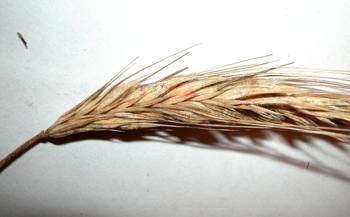Diseases
Several fungi in the genus Fusarium: F. avenaceum, F. poae, F. sporotrichioides, F. culmorum. - Head Blight of Rye.
Systematic position.
Fusarium spp. belong to imperfect fungi, class Deuteromycetes, order Moniliales, family Tuberculariaceae, genus Fusarium.Biological group.
Hemibiotrophic parasites.Symptoms.
Disease symptoms occur on diseased spikelets as salmon pink masses of conidia. Damaged seed is whitish or brown-green. Sometimes such seeds have a thin coating of pink-salmon mycelia and conidia.Morphology and biology.
All Fusarium species have one common taxonomic feature, i.e., production of distinctly shaped macroconidia (20-70 mkm) with different number of septae. The fungi overwinter by mycelii and chlamydospores in infected plant debris and seeds. Conidia are capable of producing infection if they encounter rye panicles, from flowering until harvest. Spores are spread by wind over long distances, infecting other cereal crops.Ecology.
The infection is favored by humid and warm weather during and after heading.Distribution.
Fusarium Head Blight is widely distributed where winter rye is grown. However, this disease is significant in areas with relatively cool, humid conditions during the vegetation period (North-Western, Volga-Vyatka Regions, Byelorussia, Ukraine, Baltic countries).Economic significance.
Damaged rye seeds are generally very lightweight, having a significant reduction in grain quality. Such seeds lack vitality, frequently succumbing to seedling blight. The infection can reduce seed weight by more than 25-88 %. The growth of Fusarium fungi in infected seeds promotes the production of toxic compounds (mycotoxins) that are harmful to human and animal health. To control Blight rotate small grains and corn, allowing at least one-year break in grain cultivation. Complete coverage of crop residues helps in reducing Head Blight infection. Sow adapted rye varieties in a fertile, well-prepared seedbed. No resistant varieties of rye are available, but some varieties are tolerant of the disease. The spraying of rye by fungicides is not effective. Treatment of seeds before sowing can reduce the level of infection. Storage of grain at a moisture-level of less than 14% prevents fungus growth and possible production of additional mycotoxins.Reference citations:
Buga S.F. 1999. Treatments of seeds by fungicides is the first step in protection of cereal crops against diseases. Zashchita zernovykh kul'tur, Minsk, 4: 4. (In Russian)Levitin M., Ivashchenko V., Shipilova N., Nesterov A.N., Gagkaeva T., Potorochina I.G., Afanasyeva O.B. 1994. Pathogens of Fusarium Head Blight and forms of its appearance in North-western region of Russia. Mikologiya i fitopatologiya 28(3): 58-64. (In Russian)
Piryazeva E.A. 2001. Sanitary mycological characters of grain forage in Ural and West-Siberian Regions of Russia. Ph.D. Thesis. 18 pp. (In Russian).
Shipilova N.P. 1994. Fusarium species composition and bioecological properties of pathogens of fusariosis on cereals. Ph.D. Thesis. St. Petersburg. 22 pp. (In Russian)
Shipilova N., Gagkaeva T. 1992. Fusarium Head Blight on cereal crops in the North-western region of Russia. Zashchita rastenii 11: 7-8. (In Russian)
Voilokov A.B., Gagkaeva T.Yu., Dmitriev A.P., Baranova O.A. 1998. Resistance of inbreed lines of winter rye to Brown Rust and Fusarium Head Blight. Byulleten' VIZR 78-79: 59-63. (In Russian)
© Gagkaeva T.Yu.


